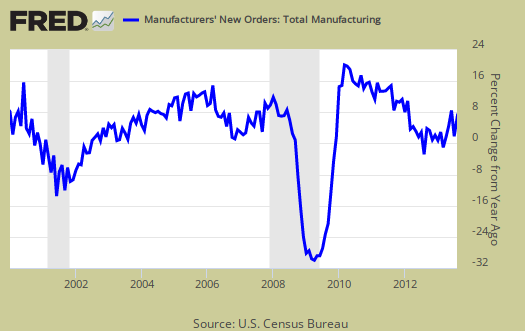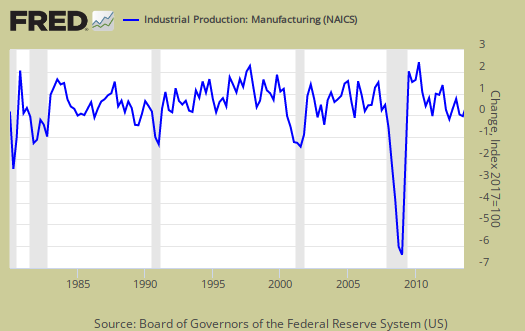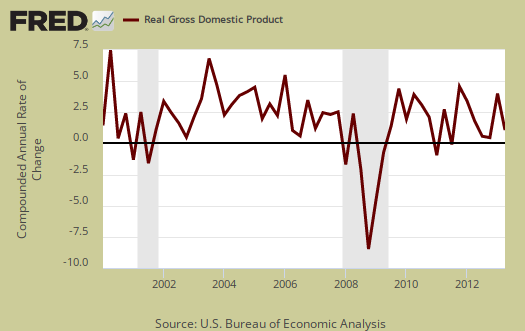The August ISM Manufacturing Survey shows PMI increased 0.3 percentage points to 55.7%. Seems the survey results held the July blow out increase and PMI is now at the highest level for the year. New orders showed the most promise, with a 4.9 percentage point increase from last month, although the production index declined.

The manufacturing survey responders comments were not as positive. Slow down was the phrase in many sectors with some noting a decrease in government spending is still hurting. The comment which stood out was from miscellaneous manufacturing, not sure why is something nobody likes to hear.
Business is slowing down, not sure why — but we may end up below last year's sales levels, whereas we had forecast 6.5 percent growth.
Back to the index, new orders increased 4.9 percentage points to 63.2%. This is the highest the new orders index has been since April 2011 and in the 60's for new orders should imply some solid growth. Below is the correlation with the Census Bureau.
A New Orders Index above 52.3 percent, over time, is generally consistent with an increase in the Census Bureau's series on manufacturing orders.

The Census reported July durable goods new orders declined by -7.3%, where factory orders, or all of manufacturing data, will be out later this month, but note the one month lag from the ISM survey. The ISM claims the Census and their survey are consistent with each other. Below is a graph of manufacturing new orders percent change from one year ago (blue, scale on right), against ISM's manufacturing new orders index (maroon, scale on left) to the last release data available for the Census manufacturing statistics. Here we do see a consistent pattern between the two.

Below is the ISM table data, reprinted, for a quick view.
| ISM Manufacturing August 2013 | ||||||
|---|---|---|---|---|---|---|
| Index | July 2013 | August 2013 | % Change. | Direction | Rate of Change | Trend Months |
| PMI™ | 55.4 | 55.7 | +0.3 | Growing | Faster | 3 |
| New Orders | 58.3 | 63.2 | +4.9 | Growing | Faster | 3 |
| Production | 65.0 | 62.4 | -2.6 | Growing | Slower | 3 |
| Employment | 54.4 | 53.3 | -1.1 | Growing | Slower | 2 |
| Supplier Deliveries | 52.1 | 52.3 | +0.2 | Slowing | Faster | 2 |
| Inventories | 47.0 | 47.5 | +0.5 | Contracting | Slower | 2 |
| Customers' Inventories | 47.5 | 42.5 | -5.0 | Too Low | Faster | 21 |
| Prices | 49.0 | 54.0 | +5.0 | Increasing | From Decreasing | 1 |
| Backlog of Orders | 45.0 | 46.5 | +1.5 | Contracting | Slower | 4 |
| Exports | 53.5 | 55.5 | +2.0 | Growing | Faster | 9 |
| Imports | 57.5 | 58.0 | +0.5 | Growing | Faster | 7 |
| OVERALL ECONOMY | Growing | Faster | 51 | |||
| Manufacturing Sector | Growing | Faster | 3 | |||
Production, which is the current we're makin' stuff now meter, decreased -2.6 percentage points from last month to 62.4%, which is somewhat surprising considering last month's new order increase. Production usually follows incoming orders in the next month, although a production index in the 60's is still strong growth.

ISM's manufacturing production index loosely correlates to the Federal Reserve's industrial production, but not at 50% as the inflection point, instead 51.2% to indicate growth. Below is a graph of the ISM manufacturing production index (left, maroon), centered around the inflection point, quarterly average, against the Fed's manufacturing industrial production index's quarterly change (scale right, blue). We can see there is a matching pattern to the two different reports on manufacturing production.

The manufacturing ISM employment index declined by -1.1 percentage points to 53.3%, which is growth. The neutral point for hiring vs. firing is 50.1%. Employment lags new orders and production, yet generally speaking it seems manufacturing employment just never gets off the ground Below are the BLS manufacturing non-farm payrolls (jobs) for the past decade on the left (maroon), graphed against the ISM manufacturing employment index on the right (blue). The BLS manufacturing payrolls is the monthly percentage change and the ISM manufacturing employment index is centered around it's inflection point of contraction and employment growth. This is just monthly change, manufacturing has lost approximately 6 million jobs over the graphed time period.

August saw inventories gain 0.5 percentage points to 47.5%, which is still contraction, for the second month in a row. As the economy is stagnant, businesses adjust inventories in response, which in turn impacts GDP. In December 2009 inventories came in at 41.9% for comparison's sake.
An Inventories Index greater than 42.7 percent, over time, is generally consistent with expansion in the Bureau of Economic Analysis' (BEA) figures on overall manufacturing inventories.

Supplier deliveries are how fast manufacturers can get their supplies. A value higher than 50 indicates slower delivery times, a value below 50 means the supply chain is speeding up. The index increased 0.2 percentage points to 52.3%, which means slower speed.

Order backlogs reversed from July and gained 1.5 percentage points to 46.5% although this is in contraction for the 4th month in a row. Backlogs of orders contraction is not good news. Less order backlogs would imply less production and might explain this month's decline.

Imports increased 0.5 percent points to 58.0% and and are in expansion or no change for the 9th month in a row. Imports are materials from other countries manufacturers use to make their products and this is the highest level of imports since April 2010.

New orders destined for export, or for customers outside of the United States increased by 2.0 percentage point to 55.5% and is in expansion for the 9th month in a row. Previous to that there was half a year of contraction.

Prices blew up by 5.0 percentage points to 54% which shows raw materials prices increased. Prices are yo-yo, up and down for the last four months.

Customer's inventories declined by 5.0 percentage points to 43.5%. Below 50 means customer's inventories are considered by manufacturers to be too low and this is a dramatic decline for a monthly change in the index. Customer inventories, not to be confused with manufacturer's inventories, are how much customers have on hand, and rates the level of inventories the organization's customers have.

Here is the ISM industrial sector ordered list of growth and contraction. Miscellaneous Manufacturing is having a tough time of it, so finding out what specifically this sector covers would give more insight as to what's going wrong.
Of the 18 manufacturing industries, 15 are reporting growth in August in the following order: Textile Mills; Wood Products; Electrical Equipment, Appliances & Components; Food, Beverage & Tobacco Products; Nonmetallic Mineral Products; Plastics & Rubber Products; Computer & Electronic Products; Printing & Related Support Activities; Furniture & Related Products; Primary Metals; Fabricated Metal Products; Transportation Equipment; Machinery; Chemical Products; and Paper Products. The only industry reporting contraction in August is Miscellaneous Manufacturing.
The ISM has a correlation formula to annualized real GDP, but they are now noting the past correlation, but note, PMI only has to be above 42.2% to indicate economic growth (right). Notice also that the PMI went to equal weighting in 2008. August's data, gives a 4.2% 2013 annual real GDP correlation. The below graph plots real GDP, left scale, against PMI, right scale, GDP up to Q2 2013. One needs to look at the pattern of the two lines to get anything out of this by quarters graph. If they match, GDP goes up, PMI goes up, would imply some correlation. Of all of the ISM's correlations, this is the one which consistently is way off.

The ISM neutral point is 50, generally. Above is growth, below is contraction, There is some some variance in the individual indexes and their actual inflection points. For example, A manufacturing PMI above 42, over time, also indicates growth, even while manufacturing is in the dumpster. Here is last month's manufacturing ISM overview, unrevised. The ISM has much more data, tables, graphs and analysis on their website. For more graphs like the above, see St. Louis Federal Reserve Fred database and graphing system. PMI™ stands for purchasing manager's index. On ISM correlations to other indexes, when in dollars they normalized to 2000 values. The above graphs do not do that, so our graphs are much more rough than what the ISM reports these indices track.
Note: The ISM is seasonally adjusting some of these indexes and not others due to the criteria for seasonal adjustment. Those indexes not seasonally adjusted are: Inventories, Customers' Inventories, Prices, Backlog of Orders, New Export Orders and Imports.

the trouble with diffusion indexes..
the ISM doesnt track hard data, it's just a survey of purchasing managers in in a number of industries...the individual indexes are based on questionnaires sent to these execs on the current conditions in their industry; each response of "better" out of a each hundred queries adds one to the index; each response of "the same" adds a half point, and responses of "worse" are not counted; hence any reading over 50 indicates a majority of those polled reported that conditions in their industry are improving....no weighting is given for the different sizes of businesses polled, or whether conditions are a whole lot better, just marginally so, or a whole lot worse...
rjs
ISM index
This is true and thus one would think the ISM wouldn't be a great indicator yet it is. We can see, from the various graphing of other economic indicators it is amazingly correlated. I like this report and how weird we have so many other reports saying inventories are contracting yet GDP showed positive change in inventories. It also is one of the first indicators for the previous month. It comes out the 1st, data is from the previous month so it gives a forward looking window.
I think they do a lot of statistical analysis behind the scenes and as one can see from the graphs, GDP is the only correlation which makes no rhyme or reason, yet there too, their long run average (I'm printing the month correlation), does follow somewhat GDP.
Anywho, that's why all of the double graphing on this overview, to show the correlations to more hard data.